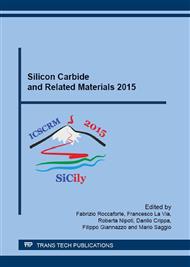p.1023
p.1028
p.1032
p.1036
p.1043
p.1049
p.1053
p.1057
p.1061
History and Recent Developments of Packaging Technology for SiC Power Devices
Abstract:
Packaging plays an important role to allow the full potential of silicon carbide devices to be realised. The physical properties of silicon carbide will allow devices to operate with junction temperatures well above 200 °C, but today standard-packaged SiC products are limited to a maximum junction temperature of 175 °C. The limitation lies in the packaging, because a power device package is a complex structure consisting of many components of different materials and with correspondingly different thermal properties. As such, the assembly technologies define both the performance and lifetime of discrete packages and power modules. In this paper we give an insight of packaging technology for SiC devices from the beginning in the mid-1980s through to the state-of-the-art of today. In addition, new packaging technologies to enable power SiC devices to operate up to 200 °C are discussed.
Info:
Periodical:
Pages:
1043-1048
Citation:
Online since:
May 2016
Authors:
Price:
Сopyright:
© 2016 Trans Tech Publications Ltd. All Rights Reserved
Share:
Citation:


